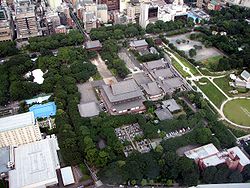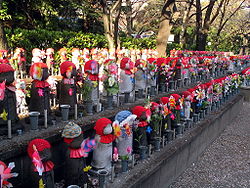
Zojo-ji
Encyclopedia


Buddhist temples in Japan
Along with Shinto shrines, Buddhist temples are the most numerous, famous, and important religious buildings in Japan.The term "Shinto shrine" is used in opposition to "Buddhist temple" to mirror in English the distinction made in Japanese between Shinto and Buddhist religious structures. In...
in the Shiba
Shiba
Shiba could refer to:* Shiba Inu, a breed of dog* Shiba, Tokyo, a former ward of Tokyo, Japan* Shiba Park in Tokyo* Ryotaro Shiba—author* Kūkaku Shiba, Ganju Shiba and Kaien Shiba—fictional characters in Bleach...
neighborhood of Minato
Minato, Tokyo
is one of the 23 special wards of Tokyo, Japan. As of 1 March 2008, it had an official population of 217,335 and a population density of 10,865 persons per km². The total area is 20.34 km².Minato hosts 49 embassies...
, Tokyo
Tokyo
, ; officially , is one of the 47 prefectures of Japan. Tokyo is the capital of Japan, the center of the Greater Tokyo Area, and the largest metropolitan area of Japan. It is the seat of the Japanese government and the Imperial Palace, and the home of the Japanese Imperial Family...
, Japan
Japan
Japan is an island nation in East Asia. Located in the Pacific Ocean, it lies to the east of the Sea of Japan, China, North Korea, South Korea and Russia, stretching from the Sea of Okhotsk in the north to the East China Sea and Taiwan in the south...
. It is the Great Main Temple of the Chinzai sect of the Shingon school. The main image is of Amida
Amida
Amida can mean:* Amitabha, an important Buddha in East Asian Buddhism* Amida , a beetle genus* Amida Buddha* Amidah, the central prayer of the Jewish services* Amidakuji, a way of drawing lots* Amitabh Bachchan, an actor...
Buddha
Buddha
In Buddhism, buddhahood is the state of perfect enlightenment attained by a buddha .In Buddhism, the term buddha usually refers to one who has become enlightened...
. The founder of Zōjō-ji was Yūyo Shōsō (酉誉聖聡).
Shūei (宗叡, 809-884), a disciple of Kūkai
Kukai
Kūkai , also known posthumously as , 774–835, was a Japanese monk, civil servant, scholar, poet, and artist, founder of the Shingon or "True Word" school of Buddhism. Shingon followers usually refer to him by the honorific titles of and ....
, founded a temple named Kōmyōji (光明寺) at Kaizuka (貝塚, present-day Kōjimachi
Kojimachi
is a neighborhood in Chiyoda, Tokyo.Prior to the arrival of Tokugawa Ieyasu, it was known as . The area developed as townspeople settled along the Kōshū Kaidō. In 1878 Kōjimachi became a ward in the city of Tokyo. It was the forerunner of Chiyoda which is now a special ward.The Kōjimachi ward was...
in Chiyoda, Tokyo
Chiyoda, Tokyo
is one of the 23 special wards in central Tokyo, Japan. In English, it is called Chiyoda ward. As of October 2007, the ward has an estimated population of 45,543 and a population density of 3,912 people per km², making it by far the least populated of the special wards...
); it is said to be the forerunner of Zōjō-ji. Centuries later, in 1393 during the Muromachi period
Muromachi period
The is a division of Japanese history running from approximately 1336 to 1573. The period marks the governance of the Muromachi or Ashikaga shogunate, which was officially established in 1338 by the first Muromachi shogun, Ashikaga Takauji, two years after the brief Kemmu restoration of imperial...
, at the time of Yūyo Shōsō, the temple converted from the Shingon to the Jōdo
Pure land
A pure land, in Mahayana Buddhism, is the celestial realm or pure abode of a Buddha or Bodhisattva. The various traditions that focus on Pure Lands have been given the nomenclature Pure Land Buddhism. Pure lands are also evident in the literature and traditions of Taoism and Bön.The notion of 'pure...
school. Shōsō is thus the founder of the present-day temple.
Together with Kan'ei-ji
Kan'ei-ji
-External links:** * National Diet Library: ; *...
, during the Edo period
Edo period
The , or , is a division of Japanese history which was ruled by the shoguns of the Tokugawa family, running from 1603 to 1868. The political entity of this period was the Tokugawa shogunate....
Zōjō-ji was the Tokugawa's family temple
Bodaiji
A , in Japanese Buddhism is a temple which, generation after generation, takes care of a family's dead giving them burial and performing ceremonies in their soul's favor. The name is because in Japan the term , which originally meant just Buddhist enlightenment , has also come to mean either the...
. Tokugawa Ieyasu
Tokugawa Ieyasu
was the founder and first shogun of the Tokugawa shogunate of Japan , which ruled from the Battle of Sekigahara in 1600 until the Meiji Restoration in 1868. Ieyasu seized power in 1600, received appointment as shogun in 1603, abdicated from office in 1605, but...
had the temple moved, first to Hibiya
Hibiya
is a geographic name covering a part of Chiyoda ward . The zone along the Hibiya Street from Yūrakuchō to Uchisaiwaichō is Hibiya district. There are many residence indications, but some indications using this word, Hibiya, like Hibiya Park and Hibiya Station...
, then in 1590, at the time of expansion of Edo Castle
Edo Castle
, also known as , is a flatland castle that was built in 1457 by Ōta Dōkan. It is located in Chiyoda in Tokyo, then known as Edo, Toshima District, Musashi Province. Tokugawa Ieyasu established the Tokugawa shogunate here. It was the residence of the shogun and location of the shogunate, and also...
, to its present location.
With the fall of the Tokugawa shogunate
Tokugawa shogunate
The Tokugawa shogunate, also known as the and the , was a feudal regime of Japan established by Tokugawa Ieyasu and ruled by the shoguns of the Tokugawa family. This period is known as the Edo period and gets its name from the capital city, Edo, which is now called Tokyo, after the name was...
, the grounds took on the character of a public park. The temple was badly damaged in World War II
World War II
World War II, or the Second World War , was a global conflict lasting from 1939 to 1945, involving most of the world's nations—including all of the great powers—eventually forming two opposing military alliances: the Allies and the Axis...
, but still retains the air of a major temple. Incidentally, the place name Daimon (大門 "Great Gate") refers to the gate of Zōjō-ji. The present gate is made of concrete.
Buildings
- Sangedatsu Gate (三解脱門 Sangedatsu MonSanmonA , also called is the most important gate of a Japanese Zen Buddhist temple, and is part of the Zen shichidō garan, the group of buildings that forms the heart of a Zen Buddhist temple. It can be however often found in temples of other denominations too...
), 1622, Important Cultural PropertyImportant Cultural Properties of JapanThe term is often shortened into just are items officially already classified as Tangible Cultural Properties of Japan by the Japanese Agency for Cultural Affairs and judged to be of particular importance to the Japanese people....
: The temple's only original structure to survive the Second World War. "San" (三) means "three", and "Gedatsu" (解脱) means "MokshaMokshaWithin Indian religions, moksha or mukti , literally "release" , is the liberation from samsara and the concomitant suffering involved in being subject to the cycle of repeated death and reincarnation or rebirth.-Origins:It is highly probable that the concept of moksha was first developed in...
". If someone passes through the gate, he can free himself from three passions (貪 Ton; "greed", 瞋 Shin; "hatred", 癡 Chi; "foolishness"). - Great Hall, 1974
Tokugawa Graves
Six of the 15 TokugawaTokugawa shogunate
The Tokugawa shogunate, also known as the and the , was a feudal regime of Japan established by Tokugawa Ieyasu and ruled by the shoguns of the Tokugawa family. This period is known as the Edo period and gets its name from the capital city, Edo, which is now called Tokyo, after the name was...
shoguns are buried at Zōjō-ji. The graves of Hidetada
Tokugawa Hidetada
was the second shogun of the Tokugawa dynasty, who ruled from 1605 until his abdication in 1623. He was the third son of Tokugawa Ieyasu, the first shogun of the Tokugawa shogunate.-Early life :...
(and the monument to his wife Sūgen'in
Oeyo
, , or : 1573 – September 15, 1626) was a prominently-placed female figure in late-Sengoku period. She married three times, first to Saji Kazunari, then to Toyotomi Hideyoshi's nephew Toyotomi Hidekatsu. Her third and last husband Tokugawa Hidetada became the second Tokugawa shogun...
), Ienobu
Tokugawa Ienobu
was the sixth shogun of the Tokugawa dynasty of Japan. He was the eldest son of Tokugawa Tsunashige, thus making him the nephew of Tokugawa Ietsuna and Tokugawa Tsunayoshi, the grandson of Tokugawa Iemitsu, the great-grandson of Tokugawa Hidetada, and the great-great grandson of Tokugawa...
, and Ietsugu
Tokugawa Ietsugu
Tokugawa Ietsugu; 徳川 家継 was the seventh shogun of the Tokugawa Dynasty, who ruled from 1713 until his death in 1716...
had been designated National Treasures of Japan
National treasures of Japan
National Treasures are the most precious of Japan's Tangible Cultural Properties, as determined and designated by the Agency for Cultural Affairs...
, but were burned in World War II. At present, parts of two of their graves have the distinction of being Important Cultural Properties of Japan
Important Cultural Properties of Japan
The term is often shortened into just are items officially already classified as Tangible Cultural Properties of Japan by the Japanese Agency for Cultural Affairs and judged to be of particular importance to the Japanese people....
. Additional graves are located in the cemetery behind the Great Hall. Parts of the grounds of the temple are now occupied by a golf practice range and a hotel.
See also
- For an explanation of terms concerning Japanese Buddhism, Japanese Buddhist art, and Japanese Buddhist temple architecture, see the Glossary of Japanese BuddhismGlossary of Japanese BuddhismThis is the glossary of Japanese Buddhism, including major terms the casual reader might find useful in understanding articles on the subject. Words followed by an asterisk are illustrated by an image in one of the photo galleries...
.

